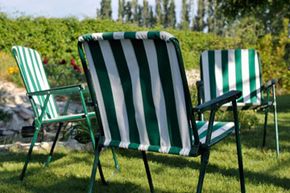When to Dethatch a Lawn and How Often
It's important to choose the right time of year to dethatch, depending upon the type of grass you have and your climate.
Dethatching is tough on a lawn, so do it when the lawn will have the best chance to recover. Don't dethatch if you're in a drought or a heat wave. Ideally, there should be about 45 days of good growing conditions after you dethatch so the grass will recover without weeds taking over. Generally, late spring and early fall are the best times, but a lot depends upon your grass and whether it grows during warm or cool weather.
Advertisement
Warm season grasses such as zoysia, Bermuda and buffalo shouldn't be dethatched in March or April, when a late frost will hurt new growth. Dethatching in fall will make them weak in winter. The best time in most areas is late spring or early summer, when these grasses are growing and producing new runners. Cool season grasses such as bluegrass, fescue and ryegrass are less likely to need dethatching, but if they do, the best time tends to be early fall. Reseeding may be necessary after dethatching. Bluegrass also can be dethatched in early spring after it has begun to turn green.
How often you dethatch also depends upon your type of grass, as well as growing conditions. Zoysia grass, Bermuda grass and other spreading grasses tend to produce more thatch. Tall fescue usually produces the least, with ryegrass and bluegrass in the middle of the scale. But soil that is clay, sandy, acidic or often wet and cold encourages thatch in many types of grass.
Dethatching can leave your lawn looking like a disaster area, especially if the blades dig into the soil. If your lawn produces a lot of thatch, dethatch annually, so that it's not such a big job. If the thatch is no more than a half-inch (1.27 centimeters) deep, you can probably get by with every other year. If it's as much as 1.5 inches (3.81 centimeters) deep, you might need to dethatch in spring and fall. If you have more thatch than that, think about digging up the lawn and starting over. Choose a grass that doesn't produce a lot of thatch, and tend it properly: Don't overwater or overfertilize. Encourage the spread of earthworms. Mow regularly, but not too closely. It's not easy, but you can keep thatch at bay.
Read on for more good lawn care information.
Related Articles
Sources
- Cook, Tom. "Lawn dethatching most overlooked spring chore." Oregon State University Extension Service. (Accessed March 24, 2011) http://extension.oregonstate.edu/gardening/node/1001
- Evans, Erv. "Renovating an Existing Lawn." N.C. State University College of Ag & Life Sciences Cooperative Extension/ Horticultural Science. (Accessed March 28, 2011) http://www.ces.ncsu.edu/depts/hort/consumer/quickref/lawns/renovating_existing.html
- Fagerness, Matthew J. "Thatch - A Hidden Lawn Concern." Horticulture Report Pamphlet. Kansas State University Agricultural Experiment Station and Cooperative Extension Service. September 2001. (Accessed March 23, 2011) http://www.ksre.ksu.edu/library/hort2/mf2131.pdf
- "Methods of Dethatching a Lawn." American-Lawns.com. (Accessed March 24, 2011)http://www.american-lawns.com/lawns/dethatching.html
- "Turfgrass Dethatching." Lawns: Maintenance. Arizona Cooperative Extension, College of Agriculture, The University of Arizona. (Accessed March 23, 2011) http://ag.arizona.edu/pubs/garden/mg/lawns/dethatching.html
- West, Dawn. "How Do I Dethatch?" All About Lawns. (Accessed March 23, 2011) http://www.allaboutlawns.com/lawn-maintenance-care/aerating-and-thatch/how-do-i-dethatch.php
- West, Dawn. "What Is Thatch?" All About Lawns. (Accessed March 23, 2011) http://www.allaboutlawns.com/lawn-maintenance-care/aerating-and-thatch/what-is-thatch.php
- West, Dawn. "When Should I Dethatch?" All About Lawns. (Accessed March 23, 2011)http://www.allaboutlawns.com/lawn-maintenance-care/aerating-and-thatch/when-should-i-dethatch.php
